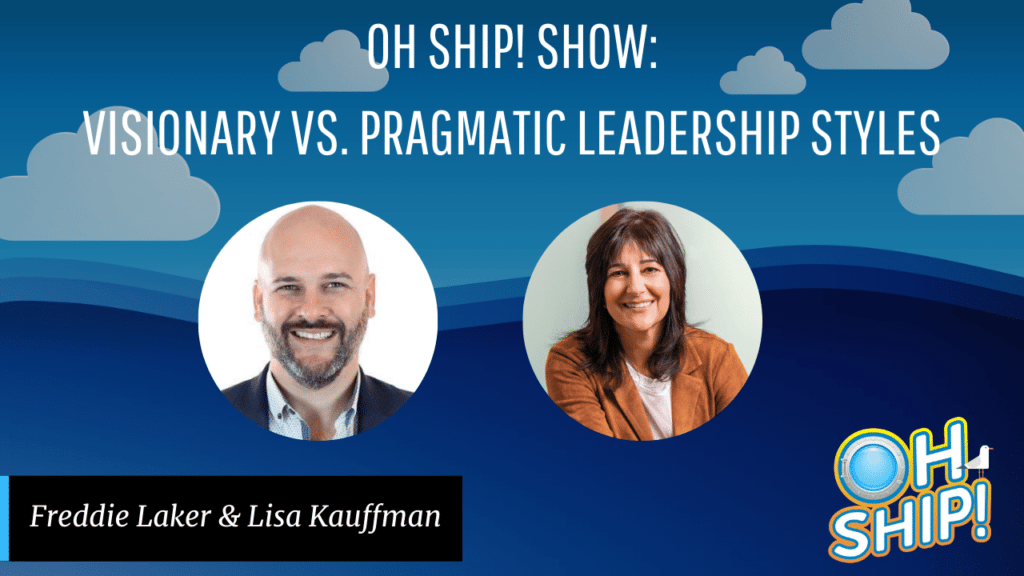Lisa and Freddie ask each other the tough questions about their preferred styles!
Lisa Kauffman, CMO of Starboard Cruise Services (part of LVMH), is bringing her retail and cruise line experience together in a single role. Previously, she has been CMO of Celebrity Cruiselines and SVP of Marketing at Macy’s. Lisa has a charismatic yet pragmatic approach to leadership. She and Freddie discussed the differences, merits, and challenges between pragmatic, realistic leadership and idealistic, visionary leadership, asking one another some hard-hitting questions!
What are the key differences between visionary and pragmatic leadership styles?
We think of visionary leaders as having pie-in-the-sky ideas and breaking boundaries, says Freddie. For better or worse, he has engaged in “hopeless optimism.” Meanwhile, a pragmatic leader embraces realism—how to get from A to Z.
“I try really hard to set big, lofty, ambitious goals, but also break things down into smaller, attainable chunks,” he says. He thinks of these as micro-goals.
“You’ve gotta have the big idea … being a pragmatic leader should not eliminate the possibility of big, bold, visionary ideas,” Lisa adds. The difference lies in where the brain focuses attention, she continues. “The pragmatic leader like myself tends to spend more time thinking about the how—how to get the team there; how to move the idea forward.”
As a pragmatic leader, what communication strategies best inspire your team to get on board with ideas?
“It’s got to be grounded in transparency and plain speak,” Lisa asserts. “We can see the eye roll when too much jargon is used.” As a leader, this outlook helps her rally her team around a way forward, communicate with other leaders, and talk with other departments. She recalls sitting through a recent presentation on streamlining marketing operations that used excruciatingly jargon-packed language—a great reminder of what not to do.
Do visionary and pragmatic leaders communicate differently?
There are three styles of leadership, asserts Freddie: Top-down, autocratic leadership; democratic, consensus-building leadership; and hands-off leadership that uses occasional coaching.
A very idealistic person may be more committed to the vision than a democratic process, while a pragmatic leader may be more likely to build consensus, he says. Some visionary leaders follow a top-down approach to pull off their big vision; they may have a low social EQ.
Freddie sees himself as a democratic leader. “I think about the vision; then, I like to share it in small doses with lots of people, then get their ideas, and then build that back into the main thought,” he explains. “I feel like that’s a way to harness their passion and then take them along for the ride because there’s a sense of ownership.”
What is another core leadership trait of a pragmatic leader?
Ownership and accountability are central for Lisa. A company can have an amazing strategy, but without those factors in place, it often goes nowhere, she says. People lose sight of what needs to happen next and who needs to bottom-line it. This is especially important in highly matrixed organizations with many interdependent people, she notes.
Too often, great ideas don’t come to fruition because it’s not clear who owns them, says Lisa. She leverages the RACI framework (“responsible, accountable, consulted, informed”) to address this issue. “It’s old school, but it’s extremely powerful and helpful for people to know what is expected of them and where they fit in in the movement of getting an idea fully executed,” she says.
What’s an example of when your idealism or absolute focus on a grand vision negatively affected you?
In 2013, Freddie launched a company called Guide. Apps were just emerging on smart TV platforms; he was convinced there would be an app revolution. So, he decided to create an app that would turn text-based news into content that viewers could passively consume. “What if I could take text and literally make it video, with images and video clips and audio, and if I could do it on the fly?” he thought.
They planned to have 3D avatars read the news—and that’s where things went sideways. “There’s this thing called the uncanny valley,” he says. When people see artificially rendered human faces that look almost realistic enough to be convincing—but not quite—it freaks us out. “Some people didn’t just dislike Guide—they were horrified by Guide,” he says. “It was like nightmare fuel to some people.” But he’d been so convinced of the idea’s merit that he built the whole app without talking to a spectrum of people. “I was so paranoid that this was such a revolutionary idea and so visionary that if anyone else saw it, they would steal it from me,” he laughs.
This was a classic case of the idea not being the issue, but the how, Lisa remarks.
What’s an example of an Oh Ship! moment when being a pragmatic leader has blown up in your face?
At a previous company, Lisa was working to launch an ecommerce site in the early days of the industry. “Lots of input was coming in, and some conflict was starting to pop up,” she says. It involved the process of getting feedback from subject matter experts and generating content. “In my pragmatic way of just [saying] let’s get to the heart of this and screw hierarchy and politically copying the world, I picked up the phone,” she said. She called the junior staff member who was experiencing a conflict with someone on her team to ask for his perspective in an effort to mediate the conflict.
But not everyone saw it that way. “From the senior leadership that person reported into, I got an earful—that I did not respect hierarchy and I did not involve management appropriately,” she said. She learned that using the proper communication channels can affect relationships for years to come.
What do you perceive as the biggest challenge for pragmatic leaders?
“Finding the right balance between being pragmatic and inspirational is essential,” says Freddie. This holds true for visionary leaders as well. “It’s about using the right tool as a leader at the right time.” Sometimes success means inspiring people; sometimes, it means reining them back in so they can prioritize.
“It’s never one-dimensional,” Lisa agrees.
If you struggle to play the other card, surround yourself with people with complementary strengths. Some brilliant leaders Freddie has known need a good wing person to be their “hype man” if they’re pragmatic. And some visionaries need someone to turn their ideas into something practical.
“It requires a level of self-awareness to recognize it and also to be okay with recognizing it,” says Lisa. “It’s pretty rare that any person or any leader has everything—all of those skill sets operating at top levels.”
How can you lead in a way that’s pragmatic as well as inspiring?
“If it’s coming from a human place, that pragmatic approach can feel warm and human and inspiring—a ‘we’re in it together’ kind of thing,” Lisa says. “To me, that level of warmth and connectedness is inspiring.”
Do pragmatic leaders show they care in different ways than visionary leaders?
A highly idealistic leader may have trouble connecting people into their vision. “If we were to generalize, we might say that the idealistic and visionary leaders are so focused on getting their big idea understood and pushed through that they’re not listening; they’re not reading the room,” Lisa says. “That may impact their ability to come off as sounding empathetic.”
“Turning up the empathy skill set in the toolkit of a leader is more important than ever,” she adds, in light of the pandemic. “It’s just a must.”
What advice would you give a pragmatic leader to help them become more successful?
It’s easy for pragmatic leaders to focus on the building blocks of a plan, says Freddie. They may forget the underlying risk of disruption that affects how they can achieve those goals, which begins with their people.
“People are not paying enough attention to the health and wellbeing of their team members,” he says. If people don’t feel like you’re prioritizing them and looking out for them and that their success is your own success, they’ll leave.
What advice would you give a visionary leader to help them become more successful?
Stop and get feedback from others—even if you believe you have a brilliant idea, Lisa advises. “You’ve got to stop and get the feedback,” she says. “Not everybody is willing to surround themselves with people who are gonna tell it to them like it is.” Surround yourself with those people so you’ll get honest input.
Did you enjoy this conversation? Subscribe and listen for more great discussions!







